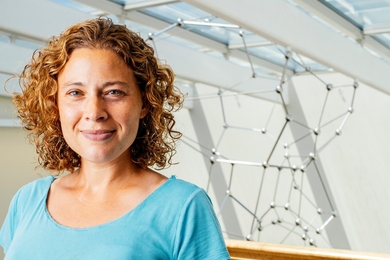How images can be used to communicate science more effectively to other scientists and to the public is one focus of an upcoming MIT conference, workshop and exhibition. The event will also address, with equal weight, the recent development of remarkable new "eyes" for seeing long-hidden worlds.
"Image and Meaning: Envisioning and Communicating Science and Technology" will be held June 13-16. Researchers and other members of the MIT community, including students, are invited to participate at a reduced rate. Go to the web site for more information and to register.
"Good pictures just naturally capture people's attention, and if the image is well made, it can help both scientists and laymen understand things more easily," said Felice Frankel, MIT research scientist and organizer of the conference. Ms. Frankel is an internationally known photographer whose images have appeared on the covers of many scientific journals.
The images to be considered at the conference range from those made by new kinds of microscopes and telescopes to new instruments that scan brains in thought and others that "see" galaxies forming in the primordial universe. Also featured will be new computer-based tools that turn confusing numerical data into informative pictures.
FOSTERING INSIGHTS
Ms. Frankel believes the conference can foster new scientific insights by inspiring researchers in one field to make use of imaging technologies developed in another. "A biologist may learn about a new technology developed for astrophysics and see ways it can be adapted to make new discoveries in biology," she said.
The conference will bring together several hundred people in disciplines ranging from science and engineering to writing and photography.
Another goal of the conference is to encourage people in the mass media, from newspapers and television to science museums, to make greater use of the wealth of new imagery to improve the public's understanding of science.
"Science and technology are advancing faster than ever," said Boyce Rensberger, conference co-organizer and a longtime science writer and editor. "This means these fields are becoming more complex than ever and harder to communicate. But because of all the new kinds of images, we have an opportunity to explain the science more effectively. The problem is that the gate-keepers in the mass media aren't aware of how much wonderful imagery is out there." Mr. Rensberger is director of MIT's Knight Science Journalism Fellowship program, which helps journalists learn more about science.
Conference presenters include leaders in many fields who will describe and show images they've created, and discuss their use of images in communication.
Among them are mathematician Benoit Mandelbrot; Sir Michael Berry, a Wolf Prize recipient in physics; Phil Campbell, editor of the journal Nature; Professor William Mitchell, dean of MIT's School of Architecture and Planning; psychologist Richard Gregory; Roald Hoffmann, a Nobel laureate in chemistry; Harvard Professor George Whitesides, a Medal of Science recipient; microscopist Shinya Inou�; and MIT Institute Professor Philip Morrison and his wife and collaborator Phylis Morrison.
Four visionaries in science and the communication arts will discuss images from science that have changed the way humanity sees itself. They are mathematician Sir Roger Penrose, writer Susan Sontag, writer and naturalist E.O. Wilson, and writer Alan Lightman of MIT's Program in Writing and Humanistic Studies.
Artists, computer modelers and cartographers will also show the newest advances in their fields, and three movie special effects studios (Digital Domain, Industrial Light and Magic, Sony Imageworks) will present their versions of "Science as Spectacle."
At small-group workshops following these and other presentations, participants will brainstorm about how imaging technologies can beused even more effectively toward communicating science to the layman and among researchers.
The "Image and Meaning" conference is sponsored by the National Science Foundation, Eastman Kodak Co. (charter sponsor), the American Chemical Society, the Camille and Henry Dreyfus Foundation, Inc., Polaroid Corp., Hewlett-Packard Laboratories, the Alfred P. Sloan Foundation, the Lynch Family Foundation, Research Corp. and the Boston Museum of Science, in addition to MIT.
Event organizers will be recruiting MIT students to serve as guides and in other support roles at this event. Interested students should contact program manager Richard Freierman.
A version of this article appeared in MIT Tech Talk on April 11, 2001.






